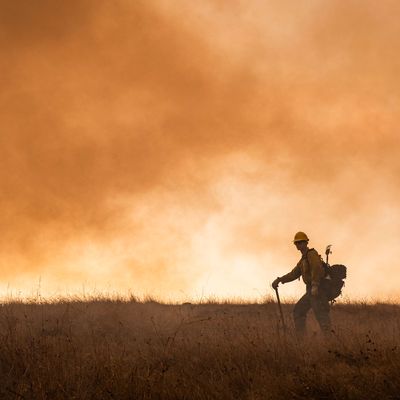
This, keep in mind, is what counts as a good year now, a light year, wildfires posing just a fraction of the threat they represented to terrified Californians just last year or the year before.
In this light year, there are, right now, more than a dozen major fires burning across California. The biggest was the Kincade Fire, in Sonoma County north of San Francisco, which burned quickly through 85 square miles, powered by winds that reached 100 miles per hour, and forced the evacuation of 180,000 as it approached Santa Rosa, which had burned just two years ago in the Tubbs Fire, which killed 22. In Southern California, also on Sunday, the Tick Fire burned 4,615 acres in Los Angeles County; then, on Sunday night, what was called the Getty Fire broke out at 2 a.m. along the 405 freeway, burning at least 400 acres and forcing the sudden evacuation of 3,300 homes. “Get out when we say get out,” Mayor Eric Garcetti said at an emergency early morning press conference. Some residents had only 15 minutes to escape.
If the phrase “Getty Fire” rings a bell for you, it should — the same area burned in 2017, in a fire (called the Skirball fire) which broke out in almost the same spot, eventually threatening Rupert Murdoch’s California home among other Bel Air estates. Fires used to sweep through even the most vulnerable communities just once a generation; they are now striking, in some places, every other year, intensifying fears, the San Francisco Chronicle reports, “that parts of California could become almost dangerous to inhabit.” This time, LeBron James was among the evacuated, tweeting, at not quite 4 a.m. local time:
Another severe wind event was forecast for Tuesday and Wednesday; the state’s embattled power utility PG&E warned that it could impact 32 counties across the state. Last week, 25 million Californians were under wildfire warning — ready to evacuate at a moment’s notice.
But thanks to a protracted quiet period throughout the summer and early fall, the total damage from this year’s wildfires — barring a catastrophic late fall — will be barely a tenth of 2018’s total, and less than a quarter of 2017’s. And yet, as a measure of just how totally unprepared even the country’s wealthy, green liberal paradise is to deal with the brutality of even today’s amount of climate change, California is entirely overwhelmed this year, too. I mean, just look at this photo, taken outside Vallejo:
Or this one:
Even evacuating grows terrifying when the roads themselves are engulfed in flames.
Last week, hoping to prevent additional wildfires that could add to the liability burden already pushing it into bankruptcy, PG&E preemptively cut power to more than a million homes, which meant that, when the fires did arrive over the weekend, communication of evacuation orders became much more difficult. Cell-phone communications were disabled, too, Southern California Edison warned that 300,000 in that region could face preventive blackouts in the week ahead. Vallejo had to declare a “water emergency” — unable to pump the necessary water to fight the fire engulfing it because of the power shutdown designed to prevent the outbreak of fire.
On Sunday, Governor Gavin Newsom declared a statewide “state of emergency,” mobilizing “every available resource” to fight the wildfires. But when the winds are this strong — predicted to be 60 to 70 mph in Northern California at midweek, and as fast as 75 mph in the southern part of the state — no amount of resources are enough. As the environmental historian Mike Davis told me in the spring, “No one will ever be honest about this, but firefighters have never stopped a wildfire powered by Santa Ana winds. All you can hope for is that the wind will change.” Garcetti told me, “There’s no number of helicopters or trucks that we can buy, no number of firefighters that we can have, no amount of brush that we can clear that will stop this. The only thing that will stop this is when the Earth, probably long after we’re gone, relaxes into a more predictable weather state.”
The pattern held this weekend. On Sunday, the Kincade Fire roughly doubled in size, the Chronicle reports, “despite the numerous air tankers, dozens of bulldozers and more than 350 engine crews hopscotching across the region in an effort to get the upper hand.” Rather than making progress, the firefighters lost ground, the fire dropping from 10 percent contained to 5 percent. “When this fire decides to make a run and the winds push it,” the Sonoma County fire chief told the paper, “you can’t win.” Early Monday morning, as if to mock even the pretense that this landscape could be controlled, an earthquake hit Sonoma just a few miles from the Kincade Fire, which still raged. A good year, a calm year.
More From This Series
- How to Live in a Catastrophe
- ‘We Woke Up and We Lost Half Our Water’
- After Two Years, Extinction Rebellion Returns





























